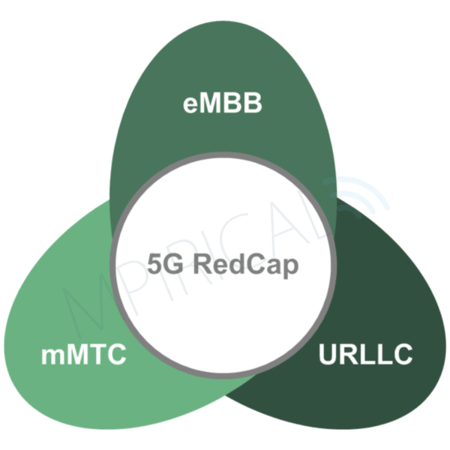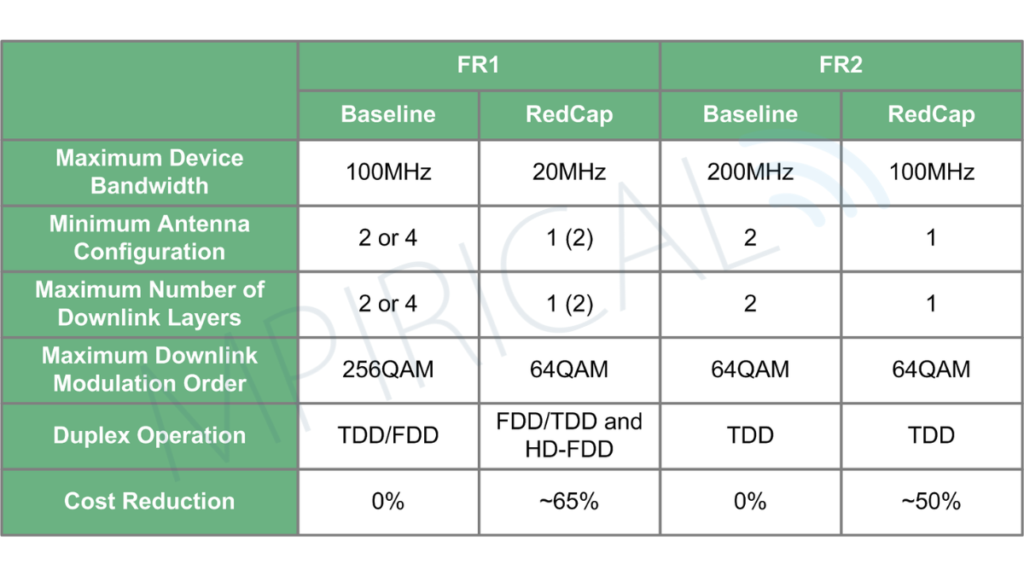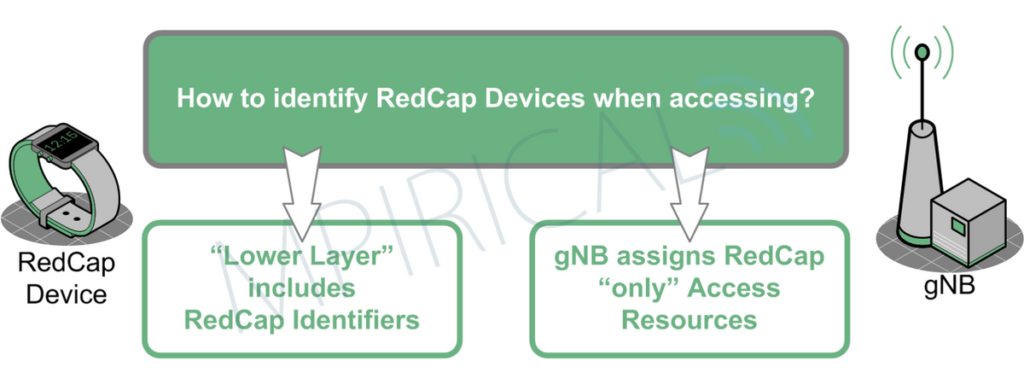
RedCap
With the finalization of 3GPP Release 17 comes the standardization of RedCap (Reduced Capabilities) devices, sometimes called “NR-Lite”. The concept of RedCap relates to the specific use-cases that don’t fall clearly in one of the original 5G service types of eMBB (Enhanced Mobile Broadband), URLLC (Ultra Reliability and Low Latency communications) or mMTC (Massive Machine Type Communications). Instead, the service requirements for RedCap devices are a mixture of all three, but typically not surpassing the baseline capabilities of each.

RedCap is designed for various use-cases, as illustrated in Figure 2. These include wearables (smart watches, AR/VR glasses/goggles etc.), video surveillance evolution, as well as industrial wireless sensors, all of which require a mixture of 5G capabilities.

So, what is “Reduced Capabilities”? Well, it relates to several limitations that enable the RedCap devices to have lower complexity, and more importantly to have a lower cost! To facilitate this lower complexity, one of the main limitations is that a RedCap device supports a maximum 20MHz channel bandwidth in FR1 (Frequency Range 1) and 100MHz in FR2 (Frequency Range 2). Figure 3 highlights the fact that a RedCap device’s capability is below the baseline of a 5G Release 15 device. These limitations are related mainly to the antenna configuration, MIMO (Multiple Input Multiple Output) layers supported, and the maximum modulation order supported. Remembering, that a baseline Release 15 device can optionally support greater capabilities.

It is worth noting there is more detail than shown in Figure 3, since there are many configurations and capabilities related to a 5G device in the 3GPP specifications. To expand on the items in Figure 3, they related to:
Reduced minimum antenna configuration – this relates to the number of Rx (Receiver) branches. The baseline varies based on the frequency band and is typically 2 or 4. In contrast the RedCap minimum is 1, however there are scenarios where it may support 2 Rx branches. This reduction limits various optimal diversity options, as well as MIMO (Multiple Input Multiple Output) support.
Maximum number of Downlink MIMO (Multiple Input Multiple Output) layers – this is closely linked to the Rx Branches mentioned previously. Assuming the device has 1 Rx Branch, then 1 Downlink MIMO layer is supported. However, as I mentioned 2 Rx branches may be supported, as such it may support 2 downlink MIMO layers in some scenarios.
Maximum Downlink Modulation Order – the support of 256QAM in the downlink is mandatory for baseline devices, however for RedCap the mandatory limit is reduced to 64QAM. However, the support of 256QAM in downlink is optional for an FR1 RedCap UE.
Duplex Operation – 5G baseline supports FD-FDD (Full Duplex – Frequency Division Duplex) and TDD (Time Division Duplex) modes, which are related to the supported bands. In addition to these, a RedCap device support HD-FDD (Half Duplex – Frequency Division Duplex). The use of HD-FDD mitigates the requirement for a duplexer in the device. In so doing, this provides a cost reduction.
Reduced Cost – overall, RedCap devices may see a cost reduction of ~65% for Frequency Range 1 and ~50% for Frequency Range 2. However, there are still options which could increase the cost.
What is not shown in Figure 3, is that many key 5G features are also not supported by RedCap devices, such as CA (Carrier Aggregation), MR-DC (Multi-RAT Dual Connectivity), DAPS (Dual Active Protocol Stacks), IAB (integrated Access and Backhaul), and the list goes on.
One key aspect of RedCap operation is being able to identify to the network, as early as possible, that you are a RedCap device. To facilitate this there are two options, the first involves the device utilizing key identifiers unique to a RedCap device at a lower layer, namely the MAC (Medium Access Control) layer. This utilizes a RedCap specific identity in the form of a LCID (Logical Channel Identifier). In so doing, the receiving gNB will be notified and act accordingly. Alternatively, the other method involves the gNB assigning access parameters (opportunities and preambles) that are reserved specifically for RedCap devices. In so doing, as a device utilizes these resources, again the gNB is aware.

Not surprisingly, once a gNB is aware of the RedCap device, other configuration changes will be made to optimize battery life, trigger relaxation of measurement etc.
Whilst I’ve not listed every aspect of RedCap, it is clear to see that these devices will play a significant part in the future of 5G. On a final note, like all 3GPP features…expect 3GPP Release 18 to future shape the requirements of RedCap.
